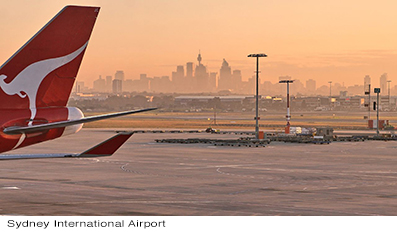Australian exporters see positive signs of focusing on specific growth markets
- News Feed
- Tuesday, 26 November 2019
DESPITE Brexit woes, US-China trade wars and an economy in Australia that’s on life support, DHL and its customers are confident the economy is going to turn for the better next year and DHL’s new Annual Export Barometer 2019 is very bullish on potential exports in 2020.
The report reveals that 69 per cent of Australian exporters are confident the coming 12 months will bring an increase in overseas orders for their businesses. Furthermore, 56 per cent of exporters reported an increase in actual orders in the past 12 months, mirroring figures from 2017.
At a state and territory level, exporters based in New South Wales/the Australian Capital Territory (69 per cent) and Victoria (65 per cent) recorded a decline in confidence, while South Australia/the Northern Territory (75 per cent), Western Australia (72 per cent), and Queensland (71 per cent) all showed increases this year.
New Zealand and North America remain top destinations
New Zealand retains its top spot as the most-popular destination for Australian businesses at 68 per cent this year. Since 2013, New Zealand has been the preferred market for Australian exporters and the only one to experience steady growth, rising 17 per cent over this period.
The North America region is in second place, with 52 per cent of Australian businesses receiving export orders from customers based there. In the past six years, the portion of exporters doing business in North America has fluctuated year-to-year, but has risen 10 per cent overall.
Growth in export orders from the UK has steadied since 2016, registering 35 per cent in 2019. Trade with markets in Asia has shown signs of softening, as China (32 per cent), Indonesia (20 per cent) and South Korea (13 per cent) all fell for Australian exporters.
 This year’s figures signal a change in tactics for export businesses, with the number of target markets dropping from three in 2018 to two in 2019.
This year’s figures signal a change in tactics for export businesses, with the number of target markets dropping from three in 2018 to two in 2019.
Tim Harcourt, host of the Airport Economist commented: “This year’s results show a greater number of small to medium-sized businesses entering the export market. For businesses new to exporting we typically see a trend where they concentrate their expansion in markets with familiar consumer buying preferences, cultures and languages. For Australian export businesses, these markets are likely to be other Western nations, such as New Zealand, the US or Canada.”
E-commerce
Sustaining return on investment, on-line channels proved a fruitful avenue for generating orders or enquiries for more than three in four Australian exporters this year.
Additionally, results pair with strategies engaged to drive on-line orders from overseas customers.
This year, export businesses have turned their focus to improving web site design (36 per cent, up nine per cent on 2018) and introducing more competitive promotions and discounts (20 per cent, up six per cent on 2018). Offering free or discounted delivery (20 per cent), improving payment functionality (17 per cent), and creating mobile-optimised (17 per cent) and localised web sites (15 per cent) all recorded increased uptake across the board.
Among the business classifications, Small Office/Home Office businesses with between one and four employees recorded the strongest participation in on-line marketing spend (42 per cent), free or discounted delivery (30 per cent) and more competitive promotions and discounts (28 per cent).
Small businesses (42 per cent) topped those improving the design of their web sites.
Gary Edstein, ceo and senior vice president for DHL Express Oceania said: “Although this year’s level of exporter confidence marks a decline on last
year’s record peak of 75 per cent – the highest level recorded since the study began in 2003 – Australian exporter confidence retains its headway at 69 per cent and marks a fifth consecutive year above the long-term average.” Businesses exporting mainly consumer goods registered the highest confidence level at 75 per cent, while agriculture (71 per cent) and services (70 per cent) followed close behind.
Confidence
Mining sector confidence experienced an upturn, with confidence growing to 65 from 50 per cent in 2018.
Meanwhile, the outlook for exporters in the manufacturing sector dropped nine per cent to sit at 63 per cent this year.
Small Office/Home Office-sized businesses were most confident (73 per cent), along with Small Businesses (71 per cent).
Continuing the trend of previous years, larger and more experienced exporters were the least confident – 52 per cent of Large Businesses and 57 per cent of businesses exporting for more than 20 years recorded the lowest levels of assurance in global exports.
 “Interestingly, this year we have observed declines in the number of exporters prioritising on-line marketing spend (down three per cent) and improving fulfilment and delivery (down seven per cent).
“Interestingly, this year we have observed declines in the number of exporters prioritising on-line marketing spend (down three per cent) and improving fulfilment and delivery (down seven per cent).
“This could indicate a trend where exporters are strategically focusing on specific areas of their business and on-line presence. Once measured improvements in these areas have been achieved, in the spirit of continuous improvement, exporters then move on to the next area of development in their business,” said Edstein.
E-commerce
Furthermore, exporter investment in e-commerce echoes trends on the personnel front. In the next 12 months, close to two thirds (65 per cent) of Australian export businesses have plans to increase wages for current employees, and half (50 per cent) are signalling moves to create new jobs to support further business growth. Among the most confident of exporters these figures register stronger, with 72 per cent to increase wages and 63 per cent to create new jobs in the coming year.
“Plans to provide employees with wage increases and the intention to create more jobs is a strong indicator of the long term outlook of the Australian exporting sector in the midst of a period of national slowdown in regards to wage growth,” said Harcourt.
Exporting
Additionally, overall declines in targeted export markets parallel exporter sentiment surrounding the US-China trade disputes – the number of exporters predicting the projected tariffs will impact business has more than doubled in the past 12 months to 45 per cent (up from 21 per cent in 2018).
Challenge
On a region-to-region basis, tariffs exist as the most common challenge faced by exporters in the Americas (30 per cent), Europe, the Middle East and Africa (28 per cent), and South East/South Asia and the Pacific (26 per cent). Furthermore, Australian exporters cite exchange rates as a constant challenge – 30 per cent of them are experiencing impacts in the Americas and 27 per cent in North East Asia.
Encouragingly, more Australian businesses are reporting no challenges this year when exporting to the regions of North East Asia (23 per cent, up from nine per cent in 2018) and Europe, the Middle East and Africa (21 per cent, up from 12 per cent in 2018).
Issues with transport and logistics have also improved across the globe for exporters – South East/South Asia and the Pacific have seen an improvement of six per cent on the previous year, while Europe, the Middle East and Africa (five per cent), and North East Asia (four per cent) all displayed increasing levels of ease.










